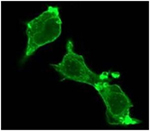A combination therapy consisting of PKC agonists with or without HDAC inhibitors, designed to reactivate latent HIV reservoirs so that HIV can be eliminated by antiviral therapy and eradicated from the body
HIV Latency
 Although highly active antiretroviral therapy (HAART) is undoubtedly a lifesaving therapy for millions of AIDS patients, the persistence of latent HIV-infected cellular reservoirs represents a major hurdle to virus eradication. Latently infected cells remain a permanent source of viral reactivation. For this reason, the eradication of viral reservoirs is at present the major goal for HIV-1 therapeutics.
Although highly active antiretroviral therapy (HAART) is undoubtedly a lifesaving therapy for millions of AIDS patients, the persistence of latent HIV-infected cellular reservoirs represents a major hurdle to virus eradication. Latently infected cells remain a permanent source of viral reactivation. For this reason, the eradication of viral reservoirs is at present the major goal for HIV-1 therapeutics.
Reactivation Is The Key
 Different authors have suggested that reactivation of the latent reservoirs with immune activation therapy could allow effective targeting and possible eradication of the virus. It is thought that viral reactivation by this therapy would result in lytic cell death of CD4+ T cells because of the cytopathic effect of the virus or through recognition of infected cells by the immune system. In addition, viral reactivation in the presence of HAART would prevent new HIV-1 infection events. Histone Deacetylase (HDAC) inhibitors and non-tumor promoter Protein Kinase C (PKC) agonists (individually or in combination) may represent a valuable pharmacological approach to purge latent HIV from cellular reservoirs.
Different authors have suggested that reactivation of the latent reservoirs with immune activation therapy could allow effective targeting and possible eradication of the virus. It is thought that viral reactivation by this therapy would result in lytic cell death of CD4+ T cells because of the cytopathic effect of the virus or through recognition of infected cells by the immune system. In addition, viral reactivation in the presence of HAART would prevent new HIV-1 infection events. Histone Deacetylase (HDAC) inhibitors and non-tumor promoter Protein Kinase C (PKC) agonists (individually or in combination) may represent a valuable pharmacological approach to purge latent HIV from cellular reservoirs.
APH-0812 with nanomolar potency is the only clinically tested PKC agonist, currently. We are also developing a number of different analogs with similar or greater efficacy than APH-0812 (US Patent Pending). Aphios manufactures APH-0812 and other active analogues of APH-0812 using proprietary and patented technologies (US Patents). We have also developed hydrophobic and nanotechnology formulations of APH-0812 and its analogues using patented and proprietary technologies for both intravenous and oral administration (US Patent Pending).
In Vitro Studies
 Using an in vitro model of HIV-1 latency, Jurkat-LAT-GFP, we have recently shown that APH-0812 reactivates HIV-1 latency in T cells through the classical PKC pathway. APH-0812, at concentrations higher than 10 nM, induced translocation of cPKCs to the plasma membrane, activated the NF-κB canonical and the MAPK (JNK and ERK) pathways.
Using an in vitro model of HIV-1 latency, Jurkat-LAT-GFP, we have recently shown that APH-0812 reactivates HIV-1 latency in T cells through the classical PKC pathway. APH-0812, at concentrations higher than 10 nM, induced translocation of cPKCs to the plasma membrane, activated the NF-κB canonical and the MAPK (JNK and ERK) pathways.
Low concentrations of APH-0812 also downregulate the expression of the human HIV-1 receptors CD4 and CXCR4 and prevent de novo HIV-1 infection. Our research indicates that the therapeutic effect of APH-0812 for HIV-1 latency can be achieved at concentrations that do not activate signal transduction pathways (i.e., canonical NF-κB activation and AP-1) that may result in adverse side effects.APH-0812 also synergizes with HDAC inhibitors to antagonize HIV-1 latency. APH-0812, at a concentration as low as 1 nM, can induce HIV-1 reactivation in the presence of therapeutically relevant concentrations of HDAC inhibitors. Thus, the therapeutic activity of APH-0812 can be drastically improved in humans by utilizing an HDAC inhibitor.
Ex Vivo Studies in Man
 We have also demonstrated in ex vivo studies that APH-0812 activates latent HIV in patients being treated with antiretroviral therapy.
We have also demonstrated in ex vivo studies that APH-0812 activates latent HIV in patients being treated with antiretroviral therapy.
Clinical Studies
APH-0812 has been tested in numerous Phase I and II clinical trials for cancer. As such, its pharmacokinetics and safety profile in humans are well known. We have collaborated with VivaCell Biotechnology España, Córdoba, Spain and are working with clinical investigators at the Department of Infectious Diseases, Ramón y Cajal Hospital, Madrid, Spain to conduct a Phase I/IIa placebo-controlled clinical trial of APH-0812 in ART-treated HIV patients in Spain. Our IMPD (IND) in Spain has been approved by the cognizant regulatory authorities and we will start enrolling patients in Q4, 2013 – Q1, 2014 time period. We are also planning to conduct in vitro and in vivo studies with APH-0812 and a selected HDAC inhibitor in non-human primates with a national primate center in the United States in order to establish the conditions for combination therapy in man, and file an IND with the US FDA.